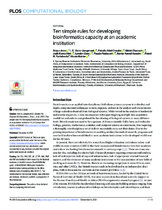| dc.contributor.author | Aron, Shaun | |
| dc.contributor.author | Jongenee, Victor | |
| dc.contributor.author | Kumuthini, Judit | |
| dc.date.accessioned | 2022-01-19T10:35:40Z | |
| dc.date.available | 2022-01-19T10:35:40Z | |
| dc.date.issued | 2021 | |
| dc.identifier.citation | Aron S, Jongeneel CV, Chauke PA, Chaouch M, Kumuthini J, Zass L, et al. (2021) Ten simple rules for developing bioinformatics capacity at an academic institution. PLoS Comput Biol 17(12): e1009592. https://doi.org/10.1371/journal. pcbi.1009592 | en_US |
| dc.identifier.uri | https://doi.org/10.1371/journal. pcbi.1009592 | |
| dc.identifier.uri | http://hdl.handle.net/10566/7121 | |
| dc.description.abstract | Bioinformatics is an applied interdisciplinary field whose primary purpose is to develop and
deploy computational techniques to store, organize, and aid in the analysis and interpretation
of large-scale data obtained from biological systems. While rooted in the analysis of nucleotide
and protein sequences, it now encompasses techniques targeting multiple data acquisition
modalities and seeks to comprehend the functioning of biological systems at many different
levels. Bioinformaticians need to be cognizant of diverse scientific fields: basic and molecular
biology, genetics, mathematics, statistics, and computer science at a minimum, thus requiring
a thoroughly interdisciplinary set of skills to successfully carry out their duties. Due to the
growing importance of bioinformatics in enabling modern biomedical research, programs and
core facilities have been established in most academic institutions in the developed world over
the last 30 years. | en_US |
| dc.language.iso | en | en_US |
| dc.publisher | Public Library of Science | en_US |
| dc.subject | Bioinformatics | en_US |
| dc.subject | Interpretation of large-scale data | en_US |
| dc.subject | Analysis | en_US |
| dc.subject | Biomedical research | en_US |
| dc.title | Ten simple rules for developing bioinformatics capacity at an academic institution | en_US |
| dc.type | Article | en_US |

